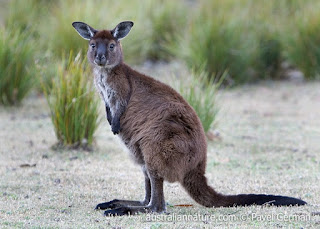Western Gray Kangaroo
THE WESTERN GRAY KANGAROO
( MACROPUS
FULIGINOSUS)
Kingdom
|
|
Phylum
|
|
Class
|
|
Order
|
|
Family
|
|
Genus
|
Description
The western grey kangaroo (Macropus
fuliginosus), is one of the largest macropods in
Australia. It weighs 28–54 kg (62–120 lb) and its length is
0.84–1.1 m (2 ft 9 in–3 ft 7 in) with a
0.80–1.0 m (2 ft 7 in–3 ft 3 in) tail, standing
approximately 1.3 m (4 ft 3 in) tall.[4] It
exhibits sexual
dimorphism with the male up to twice the size of female. It has
thick, coarse fur with colour ranging from pale grey to brown; its throat,
chest and belly have a paler colour.
This species is difficult to distinguish from its sibling species,
the eastern
grey kangaroo (Macropus giganteus). However, the western
grey kangaroo has darker grey-brown fur, darker colouration around the head,
and sometimes has a blackish patch around the elbow.
Diet
Night time is when the Western Gray
Kangaroo is found out there feeding. They will graze along the grasslands. And also
consume foods from trees and shrubs that are close to the ground.
Food
Habits
Western
grey kangaroos eat grasses, forbs, leaves, tree bark, and shrubby browse. They
use microorganisms in an organ called the cecum to digest the cellulose of
plants. This kangaroo requires very little water and is able to survive on
plants high in fiber. Western grey kangaroos spend between 6 and 10 hours
grazing per day, mostly at dawn and dusk. In captivity, these kangaroos are
often fed a pelleted grain or hay.
Habitat
Western
grey kangaroos are capable of using several different types of habitats. They
can be found in woodlands, open forests, coastal heathland, and open grassland
areas. They have also been found near city areas and on golf courses. These
kangaroos prefer areas with heterogeneous habitats, because these areas are the
most likely to meet their requirements for food and cover.
In the wild
Like other marsupials, newborn babies must climb up the mother’s body to the pouch soon after birth. This newborn baby is barely larger that a jellybean and is completely naked. Its eyes are closed and the struggle up to the pouch and to the mother’s teat is very exhausting. The joey starts to leave the pouch by 6–8 months, fully out by 11 months and independent by 12 months.
Like other marsupials, newborn babies must climb up the mother’s body to the pouch soon after birth. This newborn baby is barely larger that a jellybean and is completely naked. Its eyes are closed and the struggle up to the pouch and to the mother’s teat is very exhausting. The joey starts to leave the pouch by 6–8 months, fully out by 11 months and independent by 12 months.
Lifespan/Longevity
Western
grey kangaroos have lived to be upward of 20 years old in captivity. However,
the maximum lifespan of these kangaroos in the wild is approximately 10 years.
Reproduction
Males compete for
females, whereby dominant males mate. Dominancy is determined through
"boxing", which is a form of male competition. They are sexually
mature around three years of age. After successful mating it is only about 30
days before the young offspring will be born. It is able to move to the pouch
on its own even though it is no bigger than a lima bean. The pouch offers
protection as well as the location where the young joey is able to feed from
the body of the mother.
Mating System
Western grey kangaroos can breed continuously, but a peak in reproductive activity exists in the seasons of spring and summer. Sexual maturity is reached at approximately 20 months for males and 17 months for females. Females have an oestrous cycle of approximately 35 days. Interestingly, the western grey kangaroo is not capable of embryonic diapause. Usually, only a single offsping weighing approximately 0.8g is born after a mean gestation period of 30.5 days. The offsping, commonly called a joey, will climb from the birth canal to the pouch where it grabs hold of a teat and nurses. The joey will begin to leave the pouch after an average of 46 weeks, and may continue to nurse from the pouch for up to an additional 6 months after leaving the pouch. After the joey has left the pouch, the female is capable of mating again.
Behavior
One of the unique characteristics of this particular species of Kangaroo is
that it gives off a very powerful odor. It isn’t known why this species smells
so bad! Like other species of Kangaroos the males will engage in boxing matches
to determine who is dominant. From there they will have the right to mate with
the females in the mob.
The Western Gray
Kangaroo is more vocal than any other species. They use clicking sounds to be
able to communicate with their joeys and with the other members of their mob.
They have also been heard growling like dogs do in order to show defensive
behavior against predators.
Questions and Answers
1. Western Gray Kangaroo has a long tail, what is the function?
a. Balance while jumping
b. Walk fast
c. Run fast
d. Stand up
2. Which class does the Western Gray Kangaroo belong to?
a. Amphibia
b. Reptilia
c. Mammalia
d. Aves
3. Western Gray Kangaroo is difficult to distinguish from ....
a. Red Kangaaro
b. Wallaby
c. Tree Kangaro
d. Eastern Gray Kangaroo
4. Western Gray Kangaroo is the signature of..
a. America
b. Australia
c. India
d. Thailand
5. Western Gray Kangaroo are use .... sounds to communicate
a. Clicking
b. Whistle
c. Bark
d. Loud
Sources
http://www.arkive.org/western-grey-kangaroo/macropus-fuliginosus/
https://en.wikipedia.org/wiki/Western_grey_kangaroo
http://animaldiversity.org/accounts/Macropus_fuliginosus/
http://www.kangarooworlds.com/western-gray-kangaroo/



Komentar
Posting Komentar